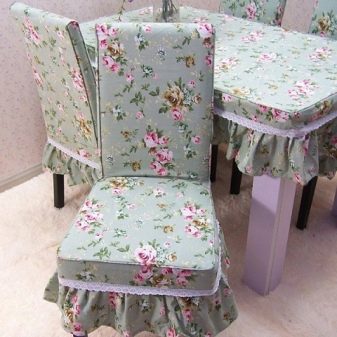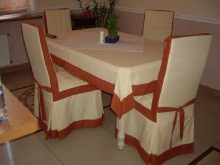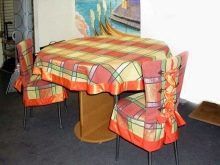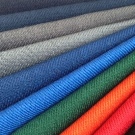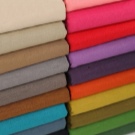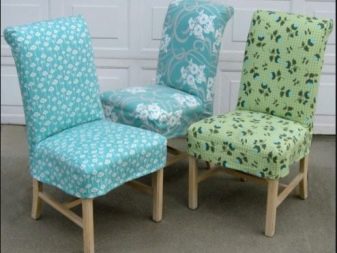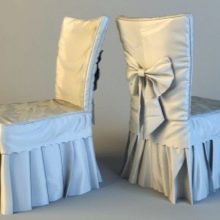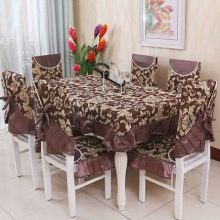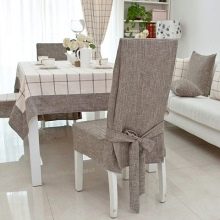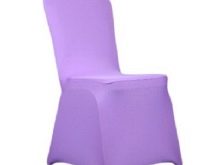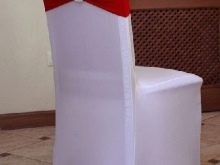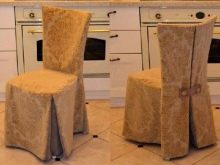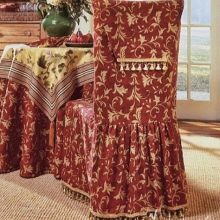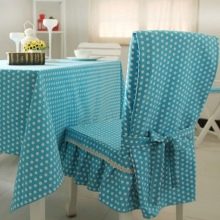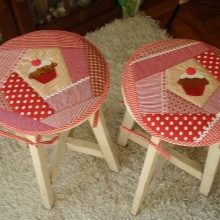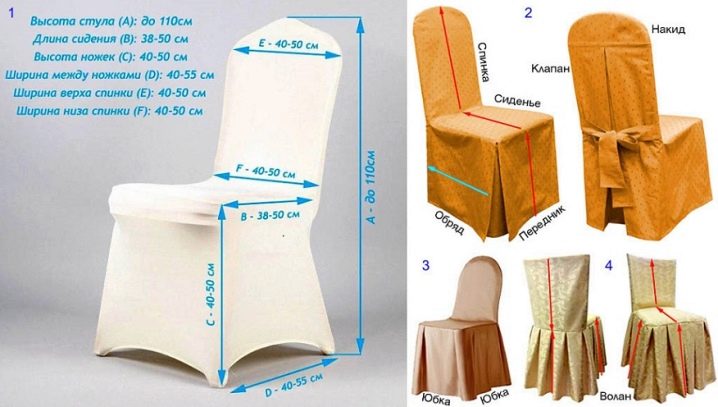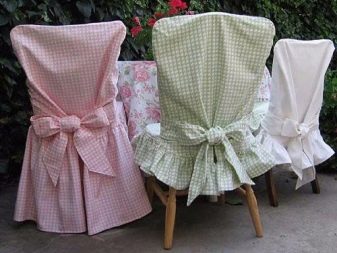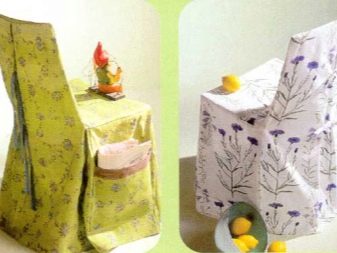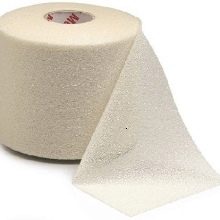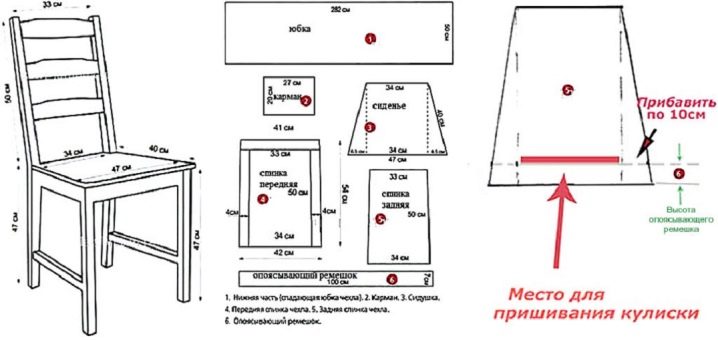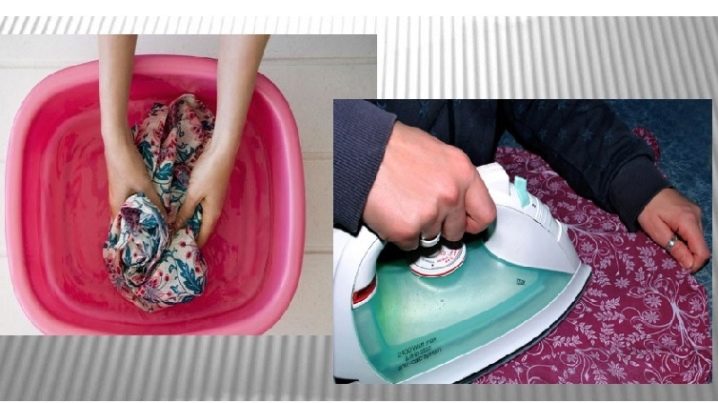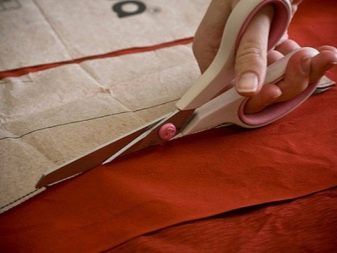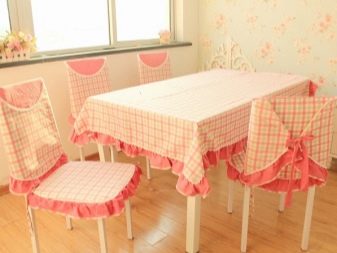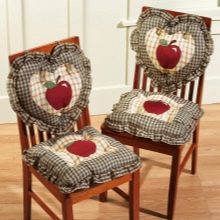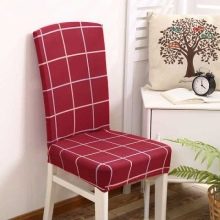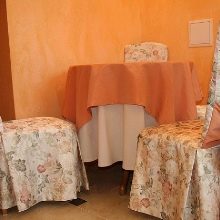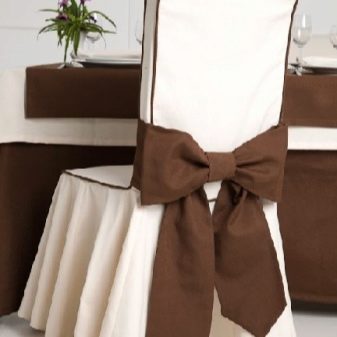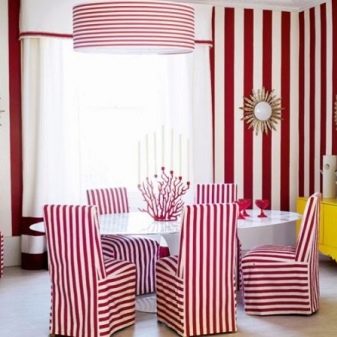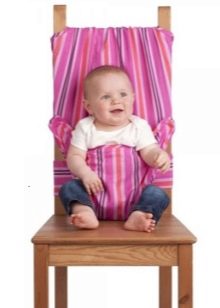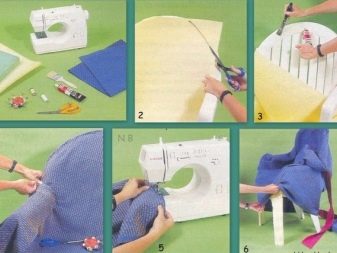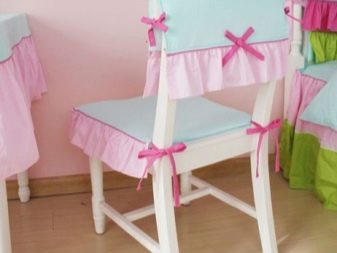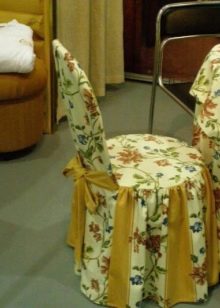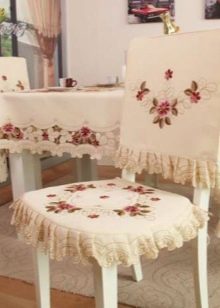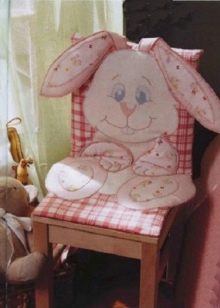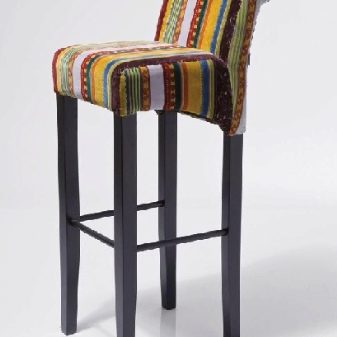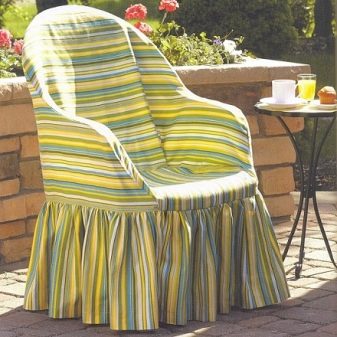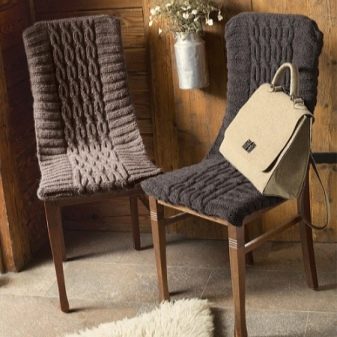Making covers for chairs do it yourself

A chair cover can solve several problems at the same time: refresh the interior, protect the chair from pollution, or, conversely, cover up rubbing or other flaws. You can buy a ready-made version, but it is not cheap, and the model will have to choose for a long time. That is why it is so popular to make chair covers with your own hands.
Materials
The choice of material will depend on many factors. Covers for chairs can be for different purposes. You can sew them only for holidays and put them on furniture before the arrival of guests. Covers for every day will be different from the holidays and in color and style.
In addition, the room itself plays a role.If the chair is in the nursery, you can choose a fabric of bright colors, for the living room of a classic design it is worth choosing light and noble shades, for kitchens in the spirit of country or Provence - a material in a cage or flower.
Regardless of the color, the fabric for covers should be:
- Strong and resistant to wear (covers will have to withstand a large load).
- Do not crumble on the cuts, because from the constant friction even the treated seams in such fabrics will spread.
- Easy to care, not absorbing pollution.
- Well ironable.
- Minimally collecting dust on itself (for this reason wool and velvety fabrics like synthetic velvet and velor are not suitable for covers.
These requirements most closely correspond to:
- Cotton fabrics: satin, twill, denim, just thick cotton fabric.
- Dense silky fabrics: satin, brocade, silk gabardine.
- Flax - a smooth cloth or fabric of a rough interlacing as a canvas.
- Biflex fabrics - canvases stretching the same both on the lobar and on the weft thread.
- Furniture fabrics - flock, microfiber and others.
Each of these materials has its own characteristics.
Cotton options are inexpensive, however, they absorb pollution and fade quickly enough. Cotton cover can be sewn on a children's or school chair - it will be a short-lived option, but the skin of the child will breathe, and sweat will be absorbed.
Denim Covers will create an unusual accent in the interior - such products will fit to country interiors, loft spaces and others.
Silky To the touch, it is better to put shiny fabrics on the front covers. They are quite slippery, and sitting on them every day will not be very comfortable. In this case, the covers of these materials are quite durable. These fabrics are perfectly draped, forming heavy and beautiful folds, bows.
Linen The options are durable and convenient because flax has the ability to self-cleaning. Spots eaten into such a fabric a little, so linen products "live" longer. Unbleached coarse flax is perfect for kitchens or living rooms in the village or eco-style. In this case, the material will look expensive. Flax finer work, originally painted, suitable for the living room in a classic style.
Materials biflex They are good because the cover of them can be precisely “planted” on a chair.Due to their high extensibility, they take on any shape. It is from such materials that ready-made universal covers are made that fit different models of chairs and armchairs. They look less presentable than options from natural fabrics. But they are durable, do not crumple and are easily erased.
Furniture fabrics difficult to tailor and cut. To work with them, you need a reliable sewing machine, thick threads and a matching needle. Usually they are weak and do not drape, but such a cover will look like a full chair upholstery. In the care of these materials are convenient because they need cleaning, not washing. They can be cleaned with a brush directly on the chair - they can withstand a lot of such operations.
The fabric should fit the chair. Furniture fabrics are best suited for soft chairs that are already upholstered in leather or fabric and have some volume. Expensive silk or linen materials do not need to be used for upholstering cheap plastic chairs and stools. Such furniture is best sheathed with a modest cotton cloth.
Calculations and measurements
Regardless of which model of the case you prefer to sew, you will need to measure and record:
- back length;
- backrest width;
- seat length;
- seat width;
- length from seat to floor if you want to completely close the legs;
- the length of the seat down as much as you want.
If you want the legs to be completely closed, for example, ruche, then you need to calculate its length as follows: the cover should not reach the floor at least 1 cm in finished form. not damaged.
It is worth considering in the calculations and additional details, such as strings, bows, pockets.
It is necessary to calculate the consumption of fabric taking into account the fact that the details were laid out along the longitudinal line. That is, the parts must be laid out parallel to the length of the thread (the main feature of the share thread is the hem, which always goes along the share thread).
If the bottom of the cover is planned to make ryushku, it is necessary to calculate its width. Shallow folds are obtained at a calculation of 1: 1.5, when you need to add half to the width of the ryushka in finished form. For example, in finished form, the width of the ruff will be 70 cm, which means that in order to lay light folds, you need to cut out the part at the rate of 70 cm + 35 cm = 105 cm.
There are proportions of folds 1: 2 (in our example it will be 70 + 70), 1: 2.5 (70 + 105), 1: 3 (70 + 140) cm, and so on. The most frequent and dense folds are obtained with a 1: 4 layout.
Usually, furniture covers are sewn from several layers of fabric. That is, only the main - external - material will not be enough. Be sure to need will be gasket materials (sintepon, foam rubber), and lining material.
Pattern building
Covers for chairs are solid, and there are separate. The one-piece model covers the entire seat and the entire back, while the details of the backrest and the seat are sewn together. The separate version is a cover on the back and a soft seat with a skirt (ruff) of any length. In principle, the details of the cut for both options will be the same, with the only difference if they will be sewn together.
For a separate cover you need to cut out the details of the top and seat. On paper, you need to build a part that is identical in shape to the shape of the back of a chair — it can be a rectangle or a rectangle with a rounded top. In size it should be exactly like the back.
This detail with seam allowances must be cut out from the main fabric, cushioning material (padding polyester) and lining.
For sitting on paper, a detail is built that is identical to the seat of a chair - square, round, trapezoid. With allowances, it is cut from basic, cushioning and lining materials.
The ryushka is cut out as a simple rectangle of the length you need (taking into account the allowance). The width in the finished form, it should be equal to the sum of the three sides of the seat (front, left and right). When building patterns you need to lay the material on the folds according to the formula described above.
For solid models, parts of the backrest and seat are similarly cut out, only the front of the back and the back will be different in length, since the front will sew with the seat and the back will simply hang down. For holiday options with bows at the back, there are triangular-shaped ties that will be sewn into the side seams.
For those who are completely unfamiliar with drawing patterns on paper, there is a life hack - dummy technique. It is necessary to glue the chair "cover" of newspapers and tape. Then - cut into parts. The resulting pieces will be patterns without allowance for seam allowances.
Cutting and sewing
An important stage before opening is the decoupling of the fabric. This operation is necessary to prevent shrinkage of the fabric after washing. If you use cotton, denim or linen, which will sit after washing, be sure to check it out.
This is done like this:
- wet a piece of fabric with water;
- dry naturally and iron a warm iron.
Thus, it will be necessary to cut the details from the already “sat down” fabric, which means that additional cover will not threaten the future cover.
Patterns need to be expanded on the fabric along the thread. Such a layout is always less economical, but it is necessary to do it this way, because the part tailored to the weft will skew in the sewing process.
Be sure to consider the direction of the pattern on the fabric!
If it is a horizontal bar, then all parts must be cut so that the bands are horizontal. If, for example, flowers are depicted on the material, then all the details must be cut out so that the stems “look” down and so on.
Cutting is made taking into account allowances for seams. On the side and top of the back you need to make wide allowances - 5-8 cm. This is necessary so that the cover passes through the thickness of the chair. On all other seams, it is sufficient to make allowances of 1.5 cm, and on the lower edge - 3 cm.
Experienced craftsmen advise to first sew a case made of inexpensive fabric - an old sheet or duvet cover. So you can see in advance all the difficult places and adjust them.
The technology of tailoring in each case is individual, but in general the sequence is as follows:
- First, you need to fold the main and lining material together to the other side, paving it with padding polyester, if it is planned. Details can be gently joined along the edge with hand stitches or machine stitching so that they do not move. Then - fold the backrest parts to the front sides of each other and stitch in the usual line, leaving 1.5 cm from the edge. It is desirable to process the cut manually with a seam "over the edge", overlock or zigzag stitching. If the fabric is synthetic and strongly flaking, its edges can be gently burned with a lighter.
- If ties are sewn into the side seams of the back of the cover, they must be made in advance. The parts are folded face to each other, grinded and turned out. It is necessary to iron the strings so that their edges are neat. Further, the ties are inserted into the side seams of the back and are ground with one stitch.
- Then the skirt is made. It is cut out, the lower section is cut with overlock or zigzag, the 3 cm seam allowance is ironed inside and secured with machine stitching. For elegant options from delicate fabrics, you can not sew on the bottom with a typewriter, but fasten this edge with glue "web",which is glued with an iron. Folds are laid on the skirt according to the proportions, fixed on top with a manual stitch.
You can simply lay the hand stitches along the whole ryushka, and then - to suck it, pulling the thread on both sides. The main thing is that it corresponds in length to the sum of the three sides of the seat to which it will be sewn.
- Next, they fasten together the main part and the seat gasket. Then, the details of the main fabric and the seat lining are face to face. The skirt is cut in to the shear. The seam must be cleaved with pins and stitched from three sides (left, right and front). Turn the part through the remaining not sewn cut.
- Cleave back and seat parts together, stitch and work out the seam.
If the cover skirt is long, it is advisable not to sew it into the seam on the seat, but carefully sew it to the finished cover on top.
Features of the children's model
The cover on the high chair is best done from thick cotton materials. The fabric will pass the air and is easy to wear. At the same time, it is not a pity to change the cover when it becomes unusable.
On the highchair for babies, you can choose water-repellent synthetic fabrics that will wash easily.Since each chair has its own design, it is possible to build a pattern only by circling the old cover on the paper. Carefully consider the places where there are seams on the finished case - some of them can not be done, but in those places where the case is bent, the pattern will need to be cut and add seam allowances.
The sewing process will be something like this:
- Fasten along the edge of the main fabric with a gasket.
- Fold face to face with lining.
- Sew to edge, leaving 20-25 cm unstitched on the side for turning.
- Unscrew the cover, straighten it, tuck the unsewn edges inside and fix it with a typewriter or manually.
- Be sure to outline where in the case there will be slots for seat belts. In these places, you need to cut holes and sweep them manually or on a typewriter using the “overcasting loop” function.
For decoration, a piping or ribbon is often sewn into the side seam of a chair cover.
Additional finish
Covers for chairs are usually trimmed with ruffles, bows, ribbons. You can use piping, soutache, lace. On kitchen covers it is advisable to sew pockets for napkins or other trifles.
For children's chairs, you can use decal.
Very beautiful on any covers look covered buttons. To do this, take the buttons "on the leg" and cover it with pieces of the main fabric cover. There are special buttons "under the skin", which disassemble the upper part - the fabric can simply be clamped between the details of the buttons. Close-fitting buttons are always made in the studio.
Examples and options
An example of how bright fabric can create a miracle. A simple bar stool is “dressed” in the simplest case, made from bright textured fabric. Ideal for ethnic interiors.
The old chair can also be updated by creating a cover for it. Such chairs look especially good in country houses and in the country. The shape of the cover repeats the shape of the back, seat and armrests. The skirt reaches almost to the floor.
A simple and attractive variant of covers for every day - the seat is made on an elastic band. Such a model of the cover tightly fit the chair and will not slip.
A cozy cover for the interior in the spirit of "Hugge" can be connected! The knitted cover is not very practical, but it is convenient because the knitwear stretches tight and well. In this embodiment, a long canvas, like a scarf. On top of the back of the item is bent and sewn on the sides, and on the seat just tucked.
How to sew separate covers on the chairs, see the next video.

